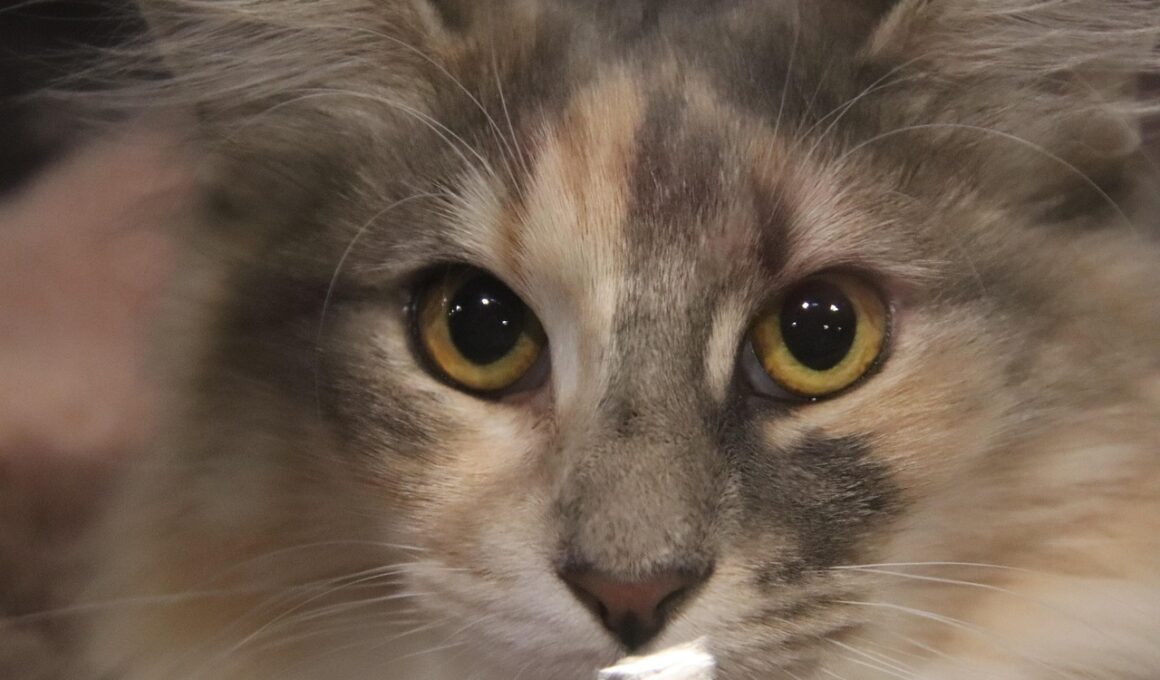The Influence of Other Cats on Show Behavior
Cat shows are not just competitions for ribbons; they serve as significant social environments for our feline friends. The presence of other cats can impact behavior in myriad ways. Observing other cats often elicits a variety of responses, such as curiosity, aggression, or fear. These interactions highlight how cats communicate and exhibit their instincts during these events. It is essential to understand how a cat’s behavior can change when surrounded by competitors and unfamiliar felines. Some cats may become more confident when they see other cats exhibiting dominance, while others may retreat due to anxiety. This range of behaviors can significantly affect overall performance during a show. Handlers play a crucial role in managing their cat’s stress and ensuring they remain calm in the face of competition. Therefore, understanding the influence of other cats can not only help owners prepare their cats for shows but also provide insights into their daily behavior. This social dynamic creates an engaging atmosphere but can also challenge a cat’s composure and adaptability in unfamiliar environments.
The exposure to a diverse range of breeds and personalities can stimulate a cat’s senses, prompting both positive and negative reactions. Different cats may respond uniquely based on their temperament. For instance, a socially confident cat might thrive under the attention of fellow felines, engaging in playful behavior, while a shy cat might demonstrate signs of distress or withdrawal. This divergence in reactions showcases the intricate nature of feline social interactions. Additionally, the environment of a cat show can exacerbate these interactions, as the confined space and presence of judges add to the stress levels of many cats. Understanding these behavioral patterns can aid in better show preparation. Cat owners are encouraged to observe their pets in various environments to prepare them for future shows. This exposure helps in conditioning them responding appropriately to stimuli present in a show atmosphere. Furthermore, socializing with other cats prior to shows can build confidence. Ultimately, the experience of interacting with multiple cats at shows can prove invaluable in enhancing their social skills, which is beneficial for their personal growth.
Another important aspect to consider is the role of scents in shaping cat behavior during shows. Cats possess a powerful sense of smell that assists them in navigating their surroundings and interpreting the behavior of others. Each cat carries its signature scent, representing its own identity. When a cat arrives at a show, it encounters a multitude of new smells from other cats. These scents can provoke various reactions, such as increased curiosity or stress. Familiar scents associated with other cats can either comfort or agitate a competing cat; this variation largely depends on past experiences with those specific animals. To manage stress levels effectively, it is advisable for handlers to prepare their cats by exposing them to different environments and scents. This exposure can be crucial for acclimating the cat to various stimuli present at the show. Proper preparation allows cats to focus better on their performance. Thus, accommodating their sensory capabilities can significantly influence a cat’s presentation. Keeping in mind the sensory experiences of cats is fundamental in shaping their performance during shows, ultimately leading to a more successful exhibition experience.
Coping Strategies for Stress Management
Stress management strategies are essential to help cats perform at their best during shows. One effective method involves creating a routine that gradually introduces your cat to new environments and other cats. This gradual exposure fosters confidence and reduces anxiety in show situations. Providing a familiar space, such as a favorite blanket or toy from home, can also help. Consistency is vital in reinforcing positive behaviors in cats. By offering a stable environment and routine, handlers can promote feelings of safety and security, enabling their cats to adapt more easily to the show atmosphere. Training sessions can also be beneficial, allowing cats to learn how to focus amid distractions. Handlers should familiarize their pets with the sounds and sights of a cat show through simulations, helping to ease their anxiety. It’s imperative to remain calm, as cats can often pick up on their owner’s stress levels. Using positive reinforcement techniques to reward desired behaviors during the show creates a more engaging atmosphere for the cat. These strategies can significantly influence a cat’s performance, showcasing the importance of preparation in feline shows.
The demeanor of judges during cat shows can also affect how cats behave. Each judge has a unique style, and their interactions can either reassure or unsettle a cat. Judges often handle many cats, and their body language, tone of voice, and approach can influence a cat’s response. For example, a gentle and calm judge may soothe a nervous cat, allowing it to relax and perform better. Conversely, a more assertive judge may provoke anxiety in sensitive cats, leading to undesirable behavior. Therefore, handlers must take note of their cat’s reactions to different judges. Understanding these dynamics can help prepare handlers to appropriately acclimate their cats to varying styles and personalities they may encounter. Some handlers choose to expose their cats to various judges through different events or workshops prior to the official show. This preparation not only builds confidence but also familiarizes the cats with potential situations during the actual competition. Ultimately, a cat’s experience with judges can play a critical role in shaping its behavior and performance at shows.
Moreover, the friendships and interactions formed between different cats at shows can play an integral role in shaping behavior and experiences. Positive interactions with other felines can build camaraderie and reduce feelings of isolation, promoting a better performance overall. Cats are naturally social creatures, and forming connections with fellow show participants might bolster their confidence levels. Handlers should encourage such friendly interactions, ensuring that their cats have opportunities to engage without fear of aggression or dominance. These engagements can assist in teaching essential socialization skills, which can be beneficial in various settings beyond competitions. However, not all interactions at shows will be positive. Some cats might face bullies or aggressive counterparts. This requires handlers to be vigilant, ready to step in when necessary to prevent negative encounters when needed. Recognizing potential conflicts and managing interactions effectively is crucial for maintaining a harmonious show environment. When cats feel safe and secure in their surroundings, they are better equipped to showcase their best traits during competitions, emphasizing the need for social dynamics to enhance their show experiences.
Conclusion: Embracing the Interactions
In summary, the influence of other cats on behavior during shows is multifaceted and significant. Factors such as the environment, scent interactions, and handling by judges all contribute to how each cat reacts and performs. Thus, ensuring positive influences and preparing them adequately can make a considerable difference in their show experience. Handlers are encouraged to invest time in socializing their cats and simulating show conditions. Awareness of the behavioral nuances can aid in minimizing stress and anxiety during competitions. It is essential to foster resilience in cats by creating positive experiences while engaging with other felines at shows. By embracing these interactions and understanding their impact, both owners and cats can navigate cat shows more effectively, leading to enjoyable and successful experiences for everyone involved. Ultimately, by prioritizing the well-being and confidence of our cats, we open doors for greater joy and fulfillment within the competitive realm of cat shows. This holistic approach can usher in a new chapter for many aspiring participants, creating enriching experiences that extend beyond merely winning.
Encouraging camaraderie and recognizing the signs of stress in cats can lead to healthier competition. When handlers and owners prioritize their cats’ mental and emotional well-being, they cultivate environments that promote optimal behaviors. Engaging effectively with the surrounding atmosphere allows cats to shine while simultaneously minimizing distress. Success goes beyond obtaining ribbons; it centers on developing well-adjusted pets that thrive in multitudes of situations. The trajectory of each cat’s journey in shows can be transformed by integrating companionship while recognizing behavioral influences. Owners should acknowledge that a supportive community can enhance not only performance but the overall joy of participating in cat shows.


